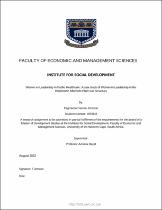| dc.contributor.advisor | Bayat, Amiena | |
| dc.contributor.author | Johnson, Fagmeeda Carelse | |
| dc.date.accessioned | 2023-03-13T06:59:39Z | |
| dc.date.issued | 2022 | |
| dc.identifier.uri | http://hdl.handle.net/11394/9742 | |
| dc.description | Magister Artium (Development Studies) - MA(DVS) | en_US |
| dc.description.abstract | Women have been progressing in the workforce over the last few decades in many countries. There has been an increase of women employed from many sectors of society in various fields in private and public sector environments. South Africa became a democratic country in 1994, giving rise to many new developments and opportunities that were previously not considered for a woman and, more specifically, a woman of color in the public sector. The International Labor Office (ILO) in 2008 drafted a report of statistics of women in employment worldwide. Figures in 2007 indicated that 1.2 billion women around the world are employed with an 18.4% increase since 1997. However, in Sub-Saharan Africa 67.9% of women are employed in agriculture and only 5.8% are employed in industry while 26.4% are employed in services (Nkomo and Ngami, 2009). | en_US |
| dc.language.iso | en | en_US |
| dc.publisher | University of the Western Cape | en_US |
| dc.subject | Public health sector | en_US |
| dc.subject | Gender inequality | en_US |
| dc.subject | Management | en_US |
| dc.subject | Women | en_US |
| dc.subject | Mitchells Plain | en_US |
| dc.title | Women in leadership in public healthcare: A case study of women in leadership in the Klipfontein Mitchell’s plain sub structure | en_US |
| dc.rights.holder | University of the Western Cape | en_US |
| dc.description.embargo | 2024 | |

